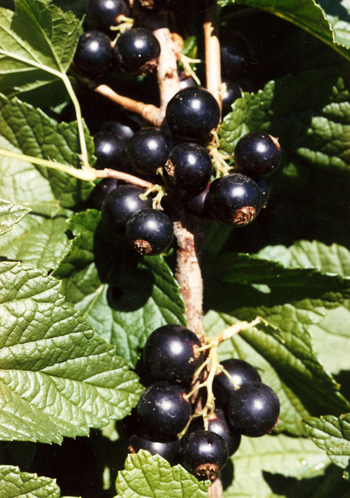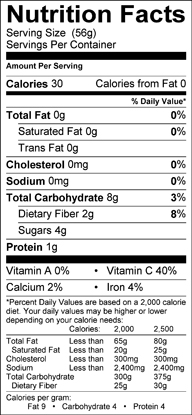Contents:
Common Names | Parts Usually Used | Plant(s) & Culture | Where Found | Medicinal Properties | Biochemical Information
Legends, Myths and Stories | Uses | Formulas or Dosages | Nutrient Content | Resource Links | Bibliography
Scientific Names

- Ribes nigrum L.
- Saxifragaceae
- Saxifrage family
Common Names
- Bugberry
- Garden black currant
- Goutberry
- Quinsy berry
- Stallberry
- Stinkshrub
Parts Usually Used
Leaves, fruit
Back to Top
Description of Plant(s) and Culture
Black currant is a small deciduous shrub, growing to a height of 6-7 feet; the leaves are alternate, palmately 3-5-lobed, doubly serrate, and more or less cordate. The large, strongly scented leaves are broader than long. Drooping racemes (in the leaf axils) of greenish-white or greenish-yellow, bell-shaped flowers appear in April and May. The fruit is a berry that is dark brown at first, turning black, juicy and round when ripe.
Back to Top
Where Found
Found in moist soils and shallow marshes. It is also cultivated in North America. Native of Europe.
Back to Top
Medicinal Properties
Diaphoretic, diuretic, nutritive, demulcent
Back to Top
Biochemical Information
Gamma-linolenic acid, vitamin C, tannin, traces of essential oil, enzyme emulsion.
Back to Top
Legends, Myths and Stories
The vitamin C content of ripe black currant berries, 120 milligrams per 3.52 oz. (100g), is said to far exceed that of citrus fruit.
Shoshone name: Owa pawump.
Washoe name: Non hal wa.
Back to Top
Uses
The leaf tea stimulates the kidneys and is good for gouty and rheumatic problems, as well as for arteriosclerosis. Drunk cold, it is also useful for hoarsness and other throat ailments. Both the leaf tea and the expressed juice of the berries can be used for whooping cough in children. The berries or their juice is also beneficial in colic pains, diarrhea, anemia. Use an infusion of the dried berries as a gargle for inflammation in the mouth and as a mouthwash for bleeding gums.
Used to flavor liqueurs and cordials.
Back to Top
Formulas or Dosages
Collect the leaves after flowering, the berries when ripe. Do not use leaves that have fungus on the lower side. Use only the leaf blades, not the petioles. Black currant is often infested with crown rust fungus.
Infusion: use 1 tsp. dried leaves to 1/2 cup water. Parboil and steep for 5 minutes. Take 1 to 1 1/2 cups a day, unsweetened, a mouthful at a time. For whooping cough only, sweeten with honey.
Infusion to make gargle or mouthwash: use 1 to 2 tsp. dried berries to 1 cup boiling water.
Berry juice: take 1 tbsp. several times a day, or as needed.
Back to Top
Nutrient Content
Vitamin C and B complex

Resource Links
LiveStrong.com: What Are the Benefits of Pomegranate & Black Currant Juice?
PubMed.gov: Characterization of Canadian black currant (Ribes nigrum L.) seed oils and residues.
Bibliography
![]() The Herb Book
The Herb Book, by John Lust, Bantam Books, 666 Fifth Avenue, New York, NY. copyright 1974.
![]() Eastern/Central Medicinal Plants
Eastern/Central Medicinal Plants, by Steven Foster and James A. Duke., Houghton Mifflin Company, 215 Park Avenue South, New York, NY 10000
![]() The Nature Doctor: A Manual of Traditional and Complementary Medicine
The Nature Doctor: A Manual of Traditional and Complementary Medicine, by Dr. H.C.A. Vogel; Keats Publishing, Inc., 27 Pine Street (Box 876) New Canaan, CT. 06840-0876. Copyright Verlag A. Vogel, Teufen (AR) Switzerland 1952, 1991
![]() Planetary Herbology
Planetary Herbology, by Michael Tierra, C.A., N.D., O.M.D., Lotus Press, PO Box 325, Twin Lakes. WI 53181., Copyright 1988, published 1992
 How Indians Use Wild Plants for Food, Medicine & Crafts
How Indians Use Wild Plants for Food, Medicine & Crafts, by Frances Densmore, Dover Publications, Inc., 180 Varick Street, New York, NY 10014, first printed by the United States Government Printing Office, Washington, in 1928, this Dover edition 1974
![]() Indian Uses of Native Plants
Indian Uses of Native Plants, by Edith Van Allen Murphey, Meyerbooks, publisher, PO Box 427, Glenwood, Illinois 60425, copyright 1958, print 1990
![]() American Folk Medicine
American Folk Medicine, by Clarence Meyer, Meyerbooks, publisher, PO Box 427, Glenwood, Illinois 60425, 1973
![]() Prescription for Nutritional Healing, Fifth Edition: A Practical A-to-Z Reference to Drug-Free Remedies Using Vitamins, Minerals, Herbs & Food Supplements
Prescription for Nutritional Healing, Fifth Edition: A Practical A-to-Z Reference to Drug-Free Remedies Using Vitamins, Minerals, Herbs & Food Supplements, by James F. Balch, M.D. and Phyllis A. Balch, C.N.C., Avery Publishing Group, Inc., Garden City Park, NY
![]() Webster’s New World Dictionary
Webster’s New World Dictionary, Third College Edition, Victoria Neufeldt, Editor in Chief, New World Dictionaries: A Division of Simon & Schuster, Inc., 15 Columbus Circle, New York, NY 10023
 An Instant Guide to Medicinal Plants
An Instant Guide to Medicinal Plants, by Pamela Forey and Ruth Lindsay, Crescent Books (January 27, 1992).
 The Healing Plants
The Healing Plants, by Mannfried Pahlow, Barron’s Educational Series, Inc. 250 Wireless Blvd., Hauppauge, NY 11788, 1992
